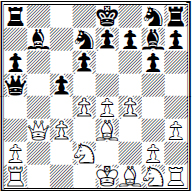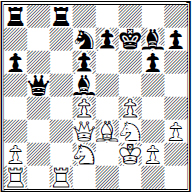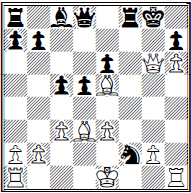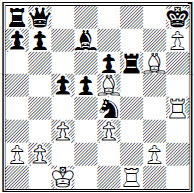| |
On June 27th MACA President Ken Ballou announced the winners of the Most Interesting Game prizes for the 79th Massachusetts Open:
Open: IM Igor Foygel
Under 2000: Danny Angermeier
Under 1800: Eugene Bedard
Under 1600: Matthew Webber
The games were judged by Rhode Island master David Griego.
White: Kelleher, Bill
Black: Foygel, Igor
[B06] Robatsch
79th Mass. Open Open
Notes by FM David Griego
1.e4 g6 2.d4 Bg7 3.Nc3 d6 4.Be3 a6 5.h3 b5 6.f4?! This is a somewhat odd mix of systems against the Modern with ...a6. The "pure Austrian" set-up with Nf3 and Bd3 is considered the main line, and a Be3, Qd2 (with perhaps h4) formation is also quite testing. 6...b4 7.Nb1 Bb7 8.Nd2 c5?! Perhaps provoked by White's slow play, Black looks to take the initiative immediately. [Preparing ...c5 with 8...Nd7 seems better.] 9.c3?! Ostensibly the idea is to support the center, but it seems to have the opposite effect. [Better is 9.dxc5! dxc5 with 2 possibilities for White: (if 9...Bxb2 10.Rb1 (10.cxd6?! Bxa1 11.Qxa1 Nf6 isn't quite sound) 10...Bc3 11.Ne2 is nice for White) 10.e5! spiking the g7 Bishop is critical. In general, this is a pawn structure Black should avoid in Pirc/Modern openings, as it is difficult to generate counterplay against White's center. The fact that White has control over the c4 square seems to be a bonus as well: (10.Bxc5?! accepts the pawn, but is probably not best: 10...Qc7! (10...Bxb2 11.Rb1 Bc3 12.Bxb4 is good for White) 11.Be3 (11.Bxb4 Nc6 12.Bc3 Bxc3 13.bxc3 Qxf4) 11...Bxb2 12.Rb1 Bc3 13.Ne2 Nf6 gives Black the initiative) 10...Nd7 11.Ngf3 Nh6 12.Bd3 0-0 13.Qe2 Qc7 14.0-0 gives White a nice edge. (If White is in a particularly belligerent mood, he can try 14.0-0-0!? ) ] 9...bxc3 10.bxc3 Qa5 11.Qb3 An efficient multi-purpose move, defending c3, and attacking both b7 and f7. 11...Nd7!

A very dynamic answer to White's threat. [11...Bc6 12.Nc4 is awkward for Black.] 12.Bc4 [12.Qxb7? Rb8 13.Qxa6 Qxc3 and things are falling with check: 14.Bb5 Qxa1+ 15.Ke2 cxd4 16.Bxd7+ Kxd7 17.Qa7+ Kc8 18.Bf2 (18.Qa6+ Kd8 19.Qa7 Qb2) 18...Qc1 is winning for Black.] 12...cxd4! Another counterattacking solution to White's threat. Black has calculated that the resulting complications will favor him. [12...Nh6 is also possible.] 13.Bxf7+ Kf8 14.Bxg8 [14.Bxd4 Bxd4 15.cxd4 Bxe4 16.Be6 Bxg2 17.Rh2 Bc6 leaves White with the less safe King position.; If 14.cxd4 Bxe4 15.Be6 Rb8 is even better for Black: 16.Qc4 Ngf6 17.Kf2 Bd5 18.Bxd5 Nxd5-/+; And 14.Qxb7 is a total disaster after 14...dxe3 15.Qxa8+ Kxf7-+] 14...Rxg8 15.cxd4 Bxe4 Black has emerged from the tactics with a clear edge. He has the 2 Bishops, control of d5, and a safer King. 16.Kf2 Bd5 [16...Rb8!? 17.Qd1 Rb2 looks a little more direct. It's unlikely White will survive the position after 18.Ne2 Bd3 19.Re1 Nf6] 17.Qd3 Kf7 18.Ngf3 Rgc8 19.Rhc1 Qb5!

An interesting practical solution, by a player known for making excellent practical decisions. Igor is no doubt confident his technical skills will bring home the point with the Queens off the board. [19...Kg8 or; 19...Nf6 are ways to keep the Queens on the board, although 20.f5 might create some counterplay.] 20.Qxb5 axb5 21.Rxc8 Rxc8 22.Rb1 [22.a4 Ra8 23.a5 Ra6 isn't dangerous for Black, as he can go after the a-pawn with ...Nb8-c6, or even ...Nc5!?-b7.] 22...Rb8 23.Ng5+ Ke8 24.a3 Nf6 25.g4 Kd7 26.Ke2 Bc6 27.Kd3 h6 [27...Ra8!? targets the a-pawn immediately, and Black has a virtually winning position after: 28.Rb3 Bd5 29.Rxb5 (29.Rc3 Ba2! and ...Nd5 is unstoppable.) 29...Rxa3+ 30.Ke2 h6 31.Ngf3 Ne4] 28.Nge4 Nd5 29.Nc3 Nxc3! Another excellent decision. Grabbing the two Bishops is attractive on the surface, but Igor most likely judged [29...Nxe3 30.Kxe3 Ra8 31.Rb3 as more difficult to convert.] 30.Kxc3 Ra8 31.Rb3 [31.Ra1 Ra4 32.Nb3 Bd5 and White's pawns will start to drop.] 31...Bd5 32.Rxb5 Rxa3+ 33.Nb3 Kc6 34.Rb4 Rxb3+ The resulting same colored Bishop ending is a clean cut win for Black: 35.Rxb3 Bxb3 36.Kxb3 Kd5 37.f5 [37.Kc3 Ke4] 37...Ke4 38.Bd2 gxf5 39.gxf5 h5 40.Bg5 Bf6 41.Bxf6 exf6 42.Kc4 h4 0-1
White:!LePoer, Geoff
Black: Angermeier, Danny
[D03] Torre Attack (Tartakower
Variation)
79th Mass. Open U2000
Notes by FM David Griego
1.d4 d5 2.Nf3 Nf6 3.Bf4 e6 4.e3 Be7 5.Bd3 0-0 6.Nbd2 Nbd7 7.Ne5 c5 8.c3 Nxe5 9.dxe5 Nd7 10.Nf3 f6 11.h4!? This at least seems to threaten something with Bxh7+, although the threat isn't really that concrete. 11...fxe5 12.Nxe5 [12.Bxh7+? Kxh7 13.Ng5+ Kg8 14.Nxe6 (14.Qh5? Nf6-+ doesn't work at all.) 14...Qb6 15.Nxf8 Kxf8 (15...exf4 16.Nxd7 Bxd7 (16...Qe6!?) 17.Qxd5+ Be6) 16.Bg3 Qxb2-/+] 12...Nf6 13.h5?! This looks like a pretty slow plan, although this h-pawn later proves to be quite a troublesome fellow. [13.Qe2 preparing Queenside castling isn't timed that well either: 13...Bd6 14.0-0-0 Qc7-/+; Since White has already taken the gloves off, he may want to stay in "hostile mode" with: 13.g4!? Bd6 14.g5 Bxe5 15.Bxe5 Ne4 16.f3 (16.Bxe4!? dxe4 17.Qxd8 Rxd8 18.c4 might reduce White's winning chances, but Black will suffer for quite a long time.) 16...Nd6 17.Qc2 creates decent attacking chances.] 13...Bd6 14.h6 g6 15.Qf3?! Stepping right into the open f-file looks risky. Perhaps worth a go is [15.Nxg6!? hxg6 16.h7+ Kh8 17.Bh6 Rf7 18.Bxg6 Rc7 19.g4 with a good amount of compensation for the piece.] 15...Bxe5 16.Bxe5 Ne4 Out of a quiet opening, we are getting some wild complications... 17.Qg4?! This is walking into a fork, but there are some even crazier things on the way. Objectively, White would rather have Black take on f2 with the Rook, for example: [17.Qe2!? Rxf2 (17...Nxf2 18.0-0 Nxd3 19.Qxd3 isn't that much fun for Black.) 18.Qg4 Rf5 19.Qxg6+! (19.Bxe4?! isn't as good: 19...Rxe5 20.0-0-0 (20.Bxg6? doesn't work due to 20...Rg5-+) 20...Bd7-/+ with a healthy extra pawn) 19...hxg6 20.h7+ Kf7 21.h8Q Qxh8 22.Bxh8 Rh5 23.Rxh5 gxh5 24.Bxe4 should lead to a draw] 17...Nxf2 18.Qxg6+!

OK! This is indeed an inspired, albeit forced, way to continue! 18...hxg6 19.Bxg6? It's tempting to threaten mate in one, but it's the wrong continuation. [19.h7+ is much better 19...Kf7 20.0-0! Ke7 (20...Ke8 21.Rxf2 Rxf2 22.h8Q+ Rf8 23.Bxg6+ with tremendous compensation for the exchange.) 21.Rxf2 Rxf2 22.Kxf2 Bd7 23.h8Q Qxh8 24.Bxh8 Rxh8 25.Bxg6=/+ somehow ends with material equality, although Black can play for a win with his better structure.] 19...Rf6? [Black should consider endingWhite's fun in a most forceful manner with 19...Qf6! 20.Bxf6 Rxf6-+ when Black is just up a piece.] 20.h7+ Kh8 21.Rh4! White's attacking chances seem to be gaining momentum.... 21...Ne4? [21...Bd7 22.Rf4 Kg7! Once the Rook is off the h-file, this active defensive move is possible. The idea is to win a tempo by attacking the Bishop. (22...Ng4 23.Rxg4 Qe7 24.0-0-0 and that dark squared Bishop is more than enough compensation for the Queen!) 23.Bc2 Ng4 24.Rxg4+ Kf7 Hard to say what the assessment here is, but getting out of that pin is some sort of moral victory.] 22.0-0-0? Threatening to take on e4 for free, but White should look at the most forcing moves first: [22.Bxe4! is most direct, and good for White: 22...dxe4 (22...Qf8 23.Ke2 Qg7 24.Rf1 is the end) 23.Rd1! (Even the slow looking 23.g4 is dangerous 23...Qe7 24.g5 Qxh7 25.Bxf6+ Kg8 26.Rxh7 Kxh7 27.Rd1+/- and Black will struggle to hold this.) 23...Bd7 (23...Qe7 24.Rh6+-) 24.Rxd7! White cashes in his chips and forces a winning King and Pawn ending: 24...Qxd7 25.Bxf6+ Qg7 26.Bxg7+ Kxg7 27.h8Q+ Rxh8 28.Rxh8 Kxh8 29.Kf2+-] 22...Bd7?? Just as in the note after Black's 19th, the best thing to do is to break the pin at all costs: [22...Qd6! 23.Rxe4 (23.Bxd6 Nxd6 24.Bc2 Bd7 25.g4 Raf8 26.g5 Rf1 shouldn't be too much trouble for Black) 23...Qxe5 24.Rxe5 Rxg6 25.Rh1 Bd7 and Black can just triple-team the h7 pawn with ...Rg7, .....Rf8-f7 ending all counterplay.] 23.Rf1?? [23.Bxe4! still wins a similar King and Pawn ending after: 23...dxe4 (23...Kg7 24.Rf1 wins a massive amount of material) 24.Rxd7!? (Although here White can make use of the access to the f-file he didn't have in the 22.Bxe4! variation, and play: 24.Rf1+- ) 24...Qxd7 25.Bxf6+ Qg7 26.Bxg7+ Kxg7 27.h8Q+ Rxh8 28.Rxh8 Kxh8 29.Kc2+-] 23...Qb8!

White: Strickland, Eric
Black: Bedard, Eugene
[B21] Sicilian Defense: Smith-
Morra Gambit
79th Mass. Open U1800
1.e4 g6 2.f4 d6 3.Nf3 c5 4.d4 Nd7 5.Nc3 b6 6.Bb5 a6 7.Bc6 Ra7 8.dxc5 dxc5 9.0-0 Qc7 10.Ne5 f6 11.Qd5 Nh6 12.Be3 fxe5 13.fxe5 Bb7 14.Bxh6 Bxh6 15.Qf7+ Kd8 16.Bxd7 Kxd7 17.Rad1+ Kc8 18.Qe6+ Kb8 19.Nd5 Bxd5 20.Rxd5 Rd8 21.Rfd1 Rxd5 22.Rxd5 Rb7 23.g3 Qc8 24.Qxc8+ Kxc8 25.e6 Rc7 26.Kf2 Rc6 27.c4 Rxe6 28.Kf3 Rf6+ 29.Ke2 Kc7 30.b3 g5 31.e5 Re6 32.Kf3 Bg7 33.Ke4 Kc6 34.g4 Rh6 35.Kf5 e6+ 36.Ke4 exd5+ 37.cxd5+ Kd7 38.Kf5 Rxh2 39.a3 Rf2+ 40.Kxg5 Bxe5 41.b4 cxb4 42.axb4 a5 43.b5 a4 44.d6 Kxd6 45.Kh5 a3 46.g5 Bf4 47.Kh6 Bxg5+ 48.Kg7 a2 0-1
White: Hong, Jenshiang
Black: Webber, Matthew
[B24] Sicilian, Closed
79th Mass. Open U1600
1.e4 c5 2.Nc3 Nc6 3.g3 g6 4.Bg2 Bg7 5.d3 e6 6.Be3 b6 7.Qd2 Nge7 8.Nge2 Nd4 9.0-0 Bb7 10.Nd1 0-0 11.Nc1 e5 12.c3 Ne6 13.Bh6 f5 14.Bxg7 Nxg7 15.f4 Qc7 16.Ne3 Rad8 17.Ne2 d5 18.Rac1 Qb8 19.Qc2 fxe4 20.dxe4 d4 21.Qb3+ Kh8 22.cxd4 exd4 23.Nd5 Nxd5 24.exd5 Nf5 25.Rf2 Ne3 26.a4 Nxg2 27.Rxg2 Bxd5 28.Qd3 Bxg2 29.Kxg2 Qb7+ 30.Kg1 Qd5 31.b3 Rde8 32.Nc3 Qxb3 33.Qb1 Qxb1 34.Nxb1 Re2 35.h4 Rfe8 36.Kf1 Kg7 37.Na3 d3 38.Rc3 d2 39.Rd3 Re1+ 40.Kg2 d1Q 41.Rxd1 Rxd1 0-1
|